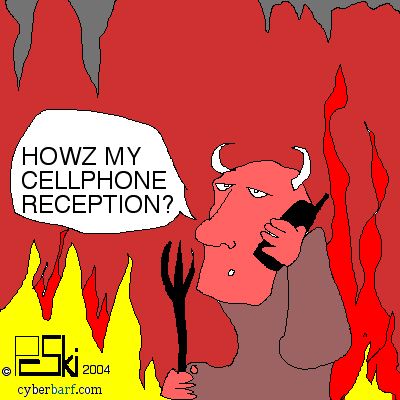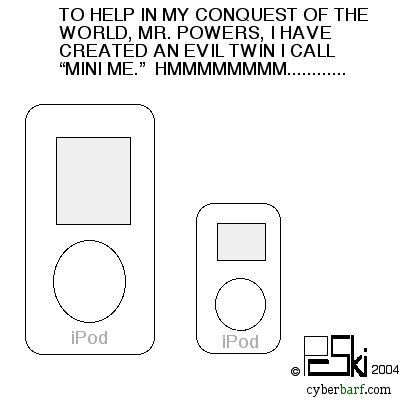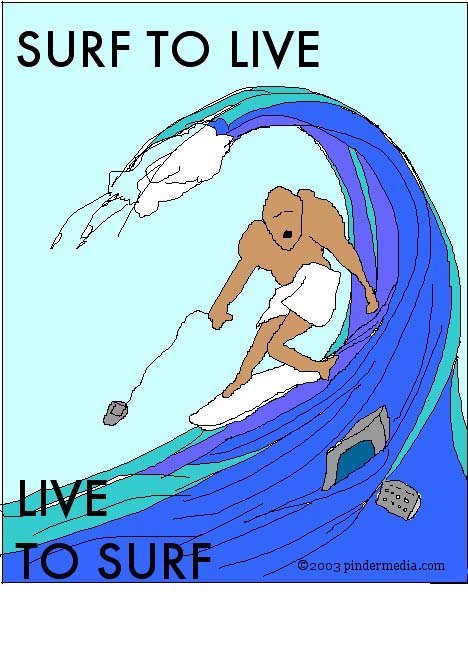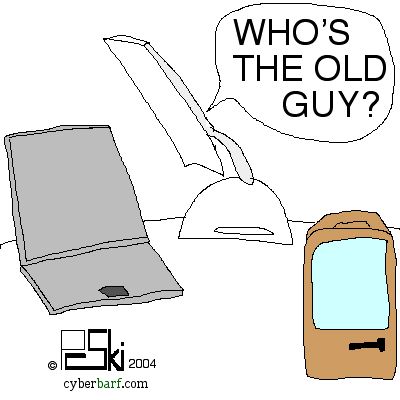cyberbarf
EXAMINE THE NET WAY OF LIFE
Low Tide
A decade ago, the rise of the Internet was more than a tidal ebb but more like a tidal wave that engulfed America. It branded deep into the brain-flesh of society. It turned corporate America on its billion dollar binge of staking out a virtual gold mine claim in cyberspace. It made millionaires with vaporware ideas and brought down billion dollar old economy corporations.
But when the Big Wave recedes, what is left beached, broken or in tatters is the Silicon Valley frontrunners and the tech industry. The public mania for tech stocks has died with the stock market bubble burst. The soundbites from the board rooms are silent on the past echoes of pushing their products or services through intranet markets. The web domain sites have plateaued and leveled off. The actual sites have decreased from a peak. Everyone had a personal website, mutated into a personal blog, and now a vast majority have become stagnant tombstones.
It is a matter of personal priority. When Times were Good during the Boom, this was the place to be; when Times turned Gray during the Gloom the priority for the last two years was finding and/or keeping your job. The webmasters, web designers, and code commandos who were the hot properties a few years ago found their cool jobs outsourced, eliminated or exported to India.
Is this a permanent shift in the climate or just Low Tide for Tech?
If we equate the Internet to the personal computer of twenty years ago (the Macintosh), there is a utilitarian dogma. The personal computer revolution used the calculating power of CPUs make obsolete the tasks of manual typing, editing, copying, creating ledgers, making hand calculations, sorting information and managing files. The critics who thought the personal PC would merely be a hobbyist toy were dead wrong since every part of current modern office is dominated by computer technology. The day does not occur without some interface with a thread of the brilliance of the early PC potential.
The Internet was supposed to change the means of personal communication. In respect, it has put the use of email and PDF attachments on par with fax machines and overnight delivery. The common postal letter is fading away like a past tradition of sending holiday Christmas cards. The Internet was supposed to change the means of business transactions. Independent exchanges would synergism the manufacturing process and supply chain. It did drive down the wholesale prices and squeezed nickels from dimes but has not eliminated the personal connection between company buyers and sellers. The direct handshake, eye to eye meeting, and the closing of the deal as still part of the international business trade because most people still want to know who they are dealing with on a personal level. The net is filled with scam artists and fraudulent schemes. Even in the world's largest fleamarket, eBay, caution and verification is practiced and preached. The troubled school systems were to become the incubators and heavy users of the Internet. No child would be left behind in access to technical and scientific information. But politics, bureaucratic waste and mismanagement continues to haunt the local schools. At best, progressive schools have a computer lab that the entire student body shares. It is the first capital expense cut when the budget turns blood red.
Computers have become as common in our lives as the telephone, radio or television receiver. We may not how it works, we just expect it to work. It has a function of a utility; ever present, constantly on, and stable. We take for granted the basic functions because they have become second nature. Writing letters (word processing), balancing a checkbook (spreadsheet) or organizing (database templates) concepts have not changed in twenty years. Users gravitate to those old, trusted programs as a convenience and time saving device. They get to a point where there is no need to upgrade to the latest software version.
The promise of the net is at a crossroads. Was all the Internet hype merely a trendy fashion statement? We still are the mercy of a 56k modem infrastructure. The deregulation of the telecommunications industry has not allowed one-stop (i.e. cheaper) telephony bills. In fact, the cost of teleco services have skyrocketed in the past decade. Just add up the sum of your landline, wireless, Internet ISP and cable bills and compare it to the oldest check ledger you have left in the old file cabinet. The Internet was supposed to replace everything: your workstation, your entertainment center; your personal socialization (chat rooms and multiplayer game centers), the way you shopped, banked and lived. It has not come close to changing our cultural norms.
The fear is that the Internet explosion was merely a fashion trend like bell-bottom jeans. It is unclear whether it has legs under the denim to run forward and become as invaluable tool as the personal computer has in the past twenty years.
The High iLife
As I kid, I used to put a white plastic Emerson 9-volt transistor AM radio under the pillow at bedtime in order to listen to the west coast broadcasts of the Cubs-Dodgers. I would fall asleep to the play-by-play. The battery would be dead by morning; but I would repeat the process. If there was no ballgame on, it would be the golden age of Top 40 radio, WCFL or WLS all night long. When the Cubs were chasing the pennant, I would sneak that radio into class and listen to the day game broadcast through that tiny little earpiece.
That was a long time ago. It was the first, portable entertainment choice in our youth.
Next were the big, bulky cassette recorders. They were the size of a text book and had piano style control keys. Most kids today only have seen a cassette tape in a 99 cent rack at truck stops. They were the original portable song devices. Who has not made a 90 minute tape from the turntable or radio for a road trip?
Technology continue to progress. Sony had those MiniDisc systems and the Walkmans, the combination of portable recorders and radio players. Target the crazed jogging set and they will buy them with their overpriced but trendy running suits. But the demand for portable music had begun to crest over the traditional high-fidelity component home stereo systems. Within a generation, the electronic store featuring the best new receivers, stack speakers, and reel to reel systems has been retired to a museum.
The Internet broadcast and music-on-demand jukebox appeal has been short lived to due copyright infringement problems and the high cost of licensing to broadband music. So the focus has been on the betterment of the personal portable music experience.
Apple's integrated iPod and iTunes music system is the zenith of the artform to date. As my tech guru, Rocky, likes to remind me, he goes nowhere without his loaded iPod music.
With the capacity for 10,000 songs, a person can program his own private radio station. There is no need for broadcast signals when you create your own playlists with ease through your own computer, or purchase new music from Apple's iTunes store for 99 cents a pop. Just as cable channels gave viewers more choice, and diluted the three major broadcast networks, the personal music revolution is diluting the ratings and power of national radio broadcast chains. The heavily programmed, plain vanilla branded radio formats creates more yawns than avid listeners. One can have a lifetime record collection in the palm of your hand. That is entertainment freedom. A generation has the choice to break away from the corporate control of music distribution and radio airplay.
I have made the choice to de-tether from the music mothership with the December purchase of an iPod. The dusty vinyl record collection now has resurfaced in the interest of recreating the record collection in digital format. It would be almost impossible to find digital copies of my existing records because most of them are out of print, obscure or were broken up by the labels to create more vinyl. There probably is a long, complicated and time-consuming way to archive the collection, but I already have a full platter of work to conquer first.
To archive the small sample of CDs that were to become the backbone of the car's 10-CD changer that still sits unused in the trunk would be an educational exercise in learning the iTunes software. Apple has had the knack of creating idiot proof, plug and play interfaces. The ease of iTunes and its initial ad campaign of Listen, Rip and Burn did not sit well with the recording labels and artist community. Under the first purchase doctrine, when one buys a record, he can make a copy of it for his own personal, non-commercial use, or afterward, sell it in a garage sale. He just cannot take his record purchases and start to sell his own Best Of record collections like those late night UHF television infomercials.
The big sale point for portable music players? Travelling. The increase in time, lay-overs and delays lead to the comfort of controlling your own down time. The stagnant state of local radio stations has lead to the increased use of portable music at work (in one's cubical) or if on the road to client meetings. And of course, the work-out warrior, listening to the beat while on the treadmill or jogging. Then lastly, the trend seekers and gadget hounds who need to have the latest, greatest device to be king-of-the-water-cooler talk.
But for me it is just the natural progression since the self-proclaimed personal year of music. I sit at my home computer with a CD playing while composing, drafting, drawing, etc. An iPod, in theory, should give me more control over the background soundtrack.
Network teleheads are scratching their heads about the sudden decline in the 18 to 54 viewership ratings. With a home DSL or cable modem, this demographic has found with simple tools they can create their own entertainment--- they are no longer tethered to a NYC programming executive. One can cut and paste tracks into your own radio station sequence. One can shoot, edit and burn your own digital movies or pictures. People get more satisfaction of creating their own product than sofa surfing for hours each night.
This is a generational shift. The current first source for news is the Internet. Prior to World War II, adults trusted newspapers and radio stations for news and information. The baby boomers shifted toward television and newspapers as primary sources of news. Now, the GenX era is focused on cable television and the Internet. Newspaper readership is literally dying out. Traditional television is fracturing into niche segments. The background radio noise during the day is being substituted with a personal music player. Personal entertainment isolation appears to be the vehicle of this change. The digital information age is moving toward the power of everything in the palm of your hand.
AVAILABLE AT THE CYBERBARF eSTORE:
New pinderWear Tees on Sale Now!!!!
New Real News merchandise!!!!
New cyberbarf Cap!!!!
THANKS FOR SUPPORTING THIS SITE.
Brain Splatter
A bad habit is not cleaning out the email in-box. This month was clearing time. 1054 junk emails had piled up in the cyberbarf general box. 1054!! From the basic spams, to stock tips (who would take advice that way?), professional logo services (I like my current self created logo), to cheap life insurance (I have enough to last a lifetime), to acceptance of immigration visas (huh? me USA citizen unless the Miami Indian tribe was successful in reclaiming the entire eastern half of the State of Illinois), and now unsolicited mail from "God" proclaiming the Word (one would think that this means of communication, being buried in the midst of the spam, not very religious). It took a wasted hour to rid the site space of the trash.
My sister-in-law has suggested that I sponsor a local youth soccer team that wears puke lime green and orange uniforms. She thought cyberbarf was appropriate sponsor for the team. Instead of a number patch on the front, the NetAddict would stare down opponents.
Which 2004 anniversary had the biggest impact on America: the 100th year anniversary of Henry Ford automobile works; the 50th anniversary of Playboy; or the 20th anniversary of the introduction of the Macintosh computer?
The 2004 buzz-slogan is media center. So easy to forget those longpast FM tuner cards, and TV motherboard cards that older PCs had the option of integrating a long time ago. The media center is a typical computer system with alot of memory and a large hard drive at an inflated price being sold to the novice electronic purchaser. The HPs and Gateways of the world are using the concept to get into electronic resellers of LCD and flat panel television screens. Microsoft wants Windows to control your recorder, television set, and eventually your home thermostat. As the PC market has matured and leveled off, the PC market makers need to find another outlet for selling their boxes and motherboards. So is it to invade the turf of the Circuit City/Best Buys or to keep a CEO's top line bonus program in tact?
Ques que se le web traffique? The stunning news I must report even shocks me--- in mid-January, 2004, cyberbarf recorded 758 unique visitors (a whopping record) for the week! Normally, there are 150 to 200 unique visitors a week to the site. (We believe unique visitors is a better reflection of circulation/users than hits.) The breakdown has an international flavor: 103 came from Europe, 32 from South America, 13 from Australia, 10 from Asia, and 7 from the military. For all the ills of desktop publishing, the Internet allows anyone the opportunity to distribute globally on a cost effective basis. We must assume that our readers find value here, and we will continue to strive to meet our mission goals. We thank everyone for the support. Viva la cyberbarf!!!!
This is a Leap Year. We get an extra day to surf the Net. Like that is gonna change anything.
WhyFi?
Our tech guru, Rocky, reports that on his way around Montana he stopped in a local Arby's for dinner. To his dismay, this restaurant had a free WiFi connection. Fast food free wireless Internet connection? It was strange and puzzling.
During the Rage, the concept of Internet cafes were touted as the means of keeping the trendy, disposal income spending, computer freaks in one place-- a bar, a coffee shop, a bookstore.... But the concept never took off. Assume the costs of wiring RJ-45 jacks in a rental space and the cable router made no sense even when a patron is paying $4 for hot java. Those same people probably have a faster java connection at home or at school.
But the WiFi buzz is the same pony glossed up with prospect of the ease of connection (no hard wire jacks). It is latest godsend tech story from the financial press. If you repeat it often enough, people will believe that it is the greatest thing since sliced bread.
When I go to a fast food restaurant, I have simple expectations. Take my order, make it hot, don't screw it up, don't make me wait too long. No one has a “lunch hour” anymore. Some of us never had one. So why a restaurant owner would want to offer a wireless net connection to his patrons is strange and puzzling. It was near a high school; but it had to be too far away from a clever student trying to zip his next class teacher's pop quiz questions. Unless it is now fashionable to come back to class with a melted cheese and horseradish stained keyboard, I don't see how one eats and net surfs at the same time unless you are hand fed by some Romanesque nymphs.
So where do we need these public connections?
Public lavatories? So when the baby change table comes down, weekend dad can find a page to figure out how to diaper his heir?
Trendy cocktail lounges? So when you find that special gal, you can cross-check her medical information databases?
Airplanes at 30,000 feet? So you can interface to the locked pilot cabin controls through Flight Simulator to dip the wing so you can see where you are at?
Expensive restaurants? So you can tap into the kitchen security cams to see what really is the entree?
T-shirts, Caps, Mugs. Check for Specials!
Your support keeps this Site moving forward. Thank you!
Distribution ©2001-2004 pindermedia.com, inc.
All Rights Reserved Worldwide.
Contact Information
Terms and Conditions
Trademarks
Archives






